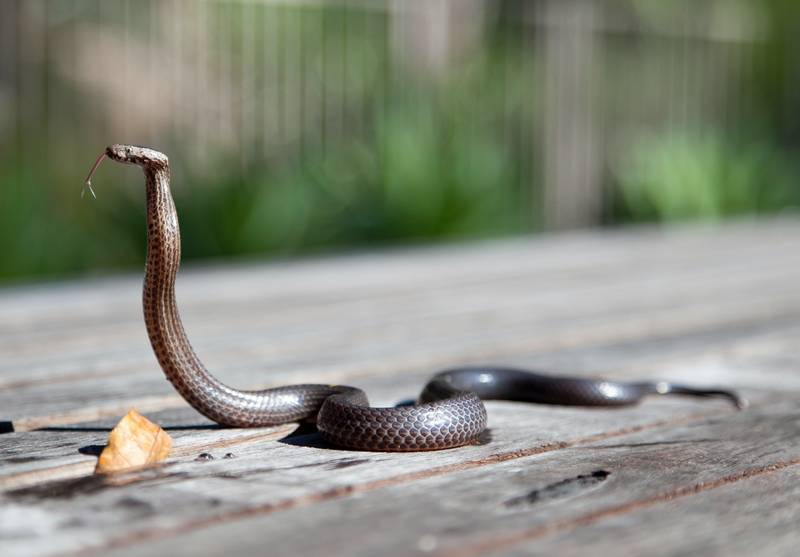Are Snakes Afraid of Dogs Barking? (+How to Stop!)
Are snakes afraid of dogs barking? In this article, we’ll answer that, plus teach you the “quiet” command to stop your dog’s aggressive behavior around them. We’ll talk about if dogs can smell snakes, and address the question of whether dogs are afraid of these slithery creatures.
Additionally, we’ll discuss whether having a dog can help deter snakes from your property, and if snakes are possibly attracted to dog poop. We’ll also explore what snakes do when a dog barks at them. Let’s get started below!
Are Snakes Afraid of Dogs Barking?

Yes, snakes can be frightened by loud noises, including dogs barking. However, their lack of external ears means they perceive sound differently than we do. They may also see dogs as a threat, prompting them to either flee or defend themselves.
Let’s delve into more about snakes’ reactions to dogs and their barking:
- Snakes’ Perception of Sound: Snakes do not have external ears, so they don’t hear sounds the same way humans or dogs do. They pick up vibrations through their jaws, allowing them to perceive sounds. A dog’s bark, being a loud and sudden noise, could create substantial vibrations, startling the snake.
- Dogs as Predators: Snakes might see a dog, especially a larger one, as a potential predator. The barking, coupled with the physical presence of a dog, can be intimidating. In response, the snake might choose to flee to a safer location.
- Snakes’ Defense Mechanisms: If a snake feels threatened and cornered, it might not run away. Instead, it might adopt a defensive posture and be ready to strike in self-defense. It’s important to keep a close watch on your dog to prevent any harmful encounters.
- Dogs’ Natural Hunting Instincts: Some breeds of dogs have strong hunting instincts and can be attracted to the movement of snakes, which can provoke barking. Always ensure your dog is supervised around areas known for snake activity to prevent potentially dangerous interactions.
While dogs barking might scare off some snakes, it’s not a reliable deterrent and many will feel provoked and may even strike. Keep your dog safe by teaching them to be quiet on command (even when a snake’s around) by following the steps in the next section.
Dog Barks at Snakes? Use the “Quiet” Command

If your dog barks at snakes, using the “Quiet” command can be an effective way to manage this behavior. The “Quiet” command involves training your dog to stop barking on your cue. This will require consistency, patience, and plenty of rewards.
Let’s walk through how to teach your dog the “Quiet” command:
- Identify the Barking Trigger: First, you need to identify what triggers your dog’s barking. In this case, it’s snakes. This will be crucial in setting up a controlled training environment.
- Command and Reward: Allow your dog to bark two or three times, then say “Quiet” in a calm, firm voice without yelling. Wait for them to stop barking, even if it’s just for a moment, then reward them immediately. You can use treats, petting, or their favorite toy as a reward. Repeat this process multiple times to make sure your dog associates stopping barking with receiving a reward.
- Practice and Consistency: Practice the “Quiet” command regularly and be consistent. Repeat the training sessions in various environments and situations to ensure that your dog will respond to the command regardless of the distractions present. Consistency is the key to success in any dog training.
- Adding Distances and Distractions: Once your dog has mastered the “Quiet” command in a controlled environment, start adding distances and distractions. Practice the command when you’re farther away, or when there are other distractions around, like other dogs or people.
These steps will get your dog to stop barking at snakes, but you need to remember that the underlying behavioral issue (anxiety, territorial dominance, overexcitement, etc.) that was causing all of this to begin with will still be present. And until you address that, any positive changes you see are only going to be temporary.
“So, how do I make these changes stick?”
By getting your dog to truly choose to follow your direction, that’s how. I tried many times to write out how you can do that before deciding it made more sense to just link you to the free video series that explains it better than I’d ever be able to.
The series is by a man named Dan who is one of the world’s leading dog obedience trainers. In it, he teaches you how to put an end to things like when your dog barks at snakes and all other misbehavior using his fast and easy-to-follow methods.
In the first video, Dan will reveal to you why the two most common methods of dog training only doom you to failure. You can watch the video now by clicking here. Follow the proven system he’ll show you in his series and you’ll never have to spend another second worrying about your dog barking at snakes ever again!
Can Dogs Smell Snakes?
Yes, dogs can smell snakes. They possess a highly developed sense of smell that allows them to detect a variety of odors, including the unique scent of snakes. This ability can vary based on the dog’s breed and individual sensory capabilities. However, whether a dog will react to the smell or understand the potential danger associated with it depends on many factors.
Dogs’ Superior Sense of Smell
Dogs have an extraordinary sense of smell. According to studies, they have between 125 to 300 million olfactory receptors in their noses, compared to the six million that humans have. This advanced olfactory system allows them to detect a wide range of scents, including those from snakes.
Breed Variations
While all dogs have a keen sense of smell, certain breeds have been specifically trained over generations to detect and track scents, making them better equipped to detect the presence of snakes. Breeds like Basset Hounds, Bloodhounds, and Beagles have superior tracking abilities and may be more adept at identifying the scent of a snake.
Snakes as a Source of Danger
Although dogs can detect the scent of snakes, it doesn’t necessarily mean they understand the potential threat a snake can pose. Without proper training, a dog might approach a snake out of curiosity rather than caution, potentially leading to harmful encounters.
Training Dogs to Avoid Snakes
For those living in areas with a high snake population, training a dog to recognize and avoid snakes can be beneficial. Some organizations offer aversion training that teaches dogs to associate the smell, sight, and sound of snakes with negative experiences, prompting them to stay away from these creatures.
In conclusion, while dogs have the ability to smell snakes, their response to the scent depends on various factors such as their breed and training. Proper training can help ensure your dog’s safety by teaching them to avoid potentially dangerous encounters with snakes. We explained how to quiet your dog on command earlier in the article.
Letting the behavior continue could lead to your dog finding it enjoyable, and soon you’ll find them going after other animals as well. Your dog will be barking at coyotes, biting salamanders, getting stung by scorpions, going after tarantulas… maybe even barking at bears! Obviously, this could be very dangerous, so it’s important to get to work right away.
Are Dogs Afraid of Snakes?
Dogs’ reactions to snakes can vary greatly. While some dogs might show fear or caution around snakes, others might display curiosity or even aggression. Much depends on the individual dog’s temperament, past experiences, and training. Dogs do not innately understand the potential danger that snakes can pose, which is why it’s crucial to supervise their interactions with wildlife and consider snake aversion training in snake-prone areas.
Dog’s Individual Temperament and Experiences
A dog’s temperament and past experiences play a significant role in how they react to snakes. Some dogs are naturally cautious and might instinctively avoid a snake, while others, particularly those with a high prey drive, may be inclined to chase or attack it. Dogs that have had negative experiences with snakes in the past, such as being bitten, might show fear when encountering them.
Lack of Innate Fear
Dogs do not possess an innate fear of snakes. They might be intrigued by the movement and noise of a snake and approach it out of curiosity rather than fear. Without proper understanding and training, this curiosity can potentially lead to dangerous situations if the snake is venomous.
In conclusion, while dogs might show a range of reactions to snakes, from fear to curiosity, they do not naturally understand the potential danger of snakes. Supervision and appropriate training can help ensure a dog’s safety when snakes are present. Teaching them the “quiet” command, which we went over earlier in this article, is also very helpful.
Do Dogs Keep Snakes Away?
While dogs can act as a deterrent to snakes due to their noise and activity, it’s not reliable or safe to use dogs as a primary method to keep snakes away. There are instances where a dog’s presence may deter a snake, but also scenarios where it could lead to dangerous encounters.
Let’s delve into this further:
- Deterrent Through Noise and Activity: Snakes often want to avoid confrontation with larger animals, including dogs. The noise and activity that dogs create can make an area less appealing to snakes, potentially causing the snakes to move elsewhere.
- Unpredictable Interactions: Dogs are curious creatures and may be inclined to investigate a snake rather than scare it away. This could potentially lead to dangerous situations, especially if the snake is venomous. Depending on the dog’s behavior and the snake’s temperament, encounters could end in either the snake being scared away or the dog being bitten.
- Snake Breeds Matter: Different species of snakes react differently to threats. While some snakes may be deterred by a dog’s presence, others may stand their ground or even attack if they feel threatened.
- Safety Concerns: Even if a dog could potentially deter snakes, it’s not safe or advisable to use a dog as a snake deterrent. Dogs are not naturally equipped to deal with snakes, and a snake bite can be extremely dangerous or even fatal to a dog.
While dogs can inadvertently deter snakes in some cases, it is not a guaranteed or safe method. If snakes are a concern in your area, consider professional snake repellent or removal services. Always prioritize your dog’s safety and do not intentionally expose them to potentially dangerous wildlife. Teach them the “quiet” command, which we explained earlier in this article.
Are Snakes Attracted to Dog Poop?
While snakes are not specifically attracted to dog poop, the presence of feces might indirectly attract them by luring prey animals, such as rats and mice, that snakes feed on. Hence, regular cleaning and proper disposal of dog poop can help deter both these prey animals and, by extension, snakes.
Prey Animals and Dog Poop
Small rodents such as rats and mice may be attracted to areas with readily available food sources, including dog poop. These rodents are a primary food source for many snake species. Consequently, if your yard is attracting rodents due to dog poop or other food sources, snakes might be drawn to the area in pursuit of their prey.
Deterrents for Snakes
While regular cleaning of dog poop can help in controlling the rodent population, additional measures can be taken to deter snakes. For instance, maintaining a clean and uncluttered yard can remove potential hiding spots for snakes. Additionally, consider using snake repellents or fencing to keep snakes away from your property.
The Role of Dog Poop in a Snake’s Diet
It’s important to note that dog poop itself is not part of a snake’s diet. Snakes are carnivorous and prefer live prey like rodents, birds, eggs, and insects. They are not attracted to dog poop for nutritional purposes but rather for the potential prey it might attract.
In summary, while snakes are not directly attracted to dog poop, it can indirectly lure them into your yard by attracting prey animals. Regularly cleaning and disposing of dog poop, controlling the rodent population, and making your yard less snake-friendly can help deter snakes from your property.
If a Dog Barks, What Do Snakes Do?
When a dog barks, snakes typically respond by trying to escape the area due to their sensitivity to vibrations and sounds. They perceive the barking as a threat and, as a defensive measure, they might coil, hiss, or even strike if they feel cornered. However, they generally prefer to avoid confrontation when possible.
Snake’s Sensitivity to Vibrations and Sounds
Snakes are sensitive to vibrations and low-frequency sounds. They perceive these through their jawbones and bodies, and this sensitivity helps them detect potential threats or prey. When a dog barks, the loud noise and accompanying ground vibrations can be picked up by the snake, making them aware of the dog’s presence and possibly leading them to view the dog as a threat.
Snake’s Defensive Behavior
In response to a perceived threat, snakes typically exhibit defensive behaviors. They may hiss, coil up, or even strike if they feel cornered. However, these behaviors are their last resort. Snakes generally prefer to escape confrontation and will likely try to flee the area if a dog is barking at them.
Dogs and Snake Interactions
While some dogs may naturally bark at and avoid snakes, others might be curious and try to interact with them. This can lead to dangerous situations if the snake is venomous. It’s recommended to keep dogs away from snakes and consider snake aversion training for dogs if you live in an area with a high snake population.
In conclusion, snakes generally react to a dog’s bark by trying to escape the situation, perceiving the noise and vibrations as a potential threat. However, each interaction can vary based on the individual behaviors of the dog and the snake, and the best course of action is always to prevent these encounters when possible by using the “quiet” command (explained earlier).
How to Keep Snakes Out of Your Yard
Keeping snakes out of your yard primarily involves managing your yard environment to make it less appealing to them. This includes removing potential hiding spots, controlling food sources like rodents, maintaining your lawn, and considering professional snake fencing. However, effectiveness can vary based on the species of snake and local ecology.
Managing Yard Environment
The first step in keeping snakes out of your yard is to make the environment less hospitable for them. Snakes are attracted to places where they can hide and find food. Removing log piles, rocks, and clutter reduces potential hiding spots. Regularly mowing your lawn and trimming plants can also discourage snakes by leaving them more exposed.
Controlling Food Sources
Snakes are often drawn to yards because they offer food sources like rodents and insects. Implementing pest control methods can help reduce these food sources, making your yard less attractive to snakes. This could involve using traps for rodents or employing professional pest control services.
Snake Fencing
Professional snake fencing is a more direct method of keeping snakes out of your yard. These fences are designed to prevent snakes from entering your property, but their effectiveness can vary depending on the snake species and the design of the fence. It’s important to consult with a professional to determine the most effective solution for your specific situation.
Professional Help
If snake presence is a recurrent problem or if you live in an area with venomous snakes, it might be beneficial to seek professional help. Wildlife control or a herpetologist can provide advice and services tailored to your specific problem and local snake species.
In conclusion, keeping snakes out of your yard involves making your yard less appealing to them by managing the environment, controlling food sources, and potentially installing snake fencing. However, in cases of persistent issues or venomous snakes, professional help should be sought.
I’m sure you’re looking forward to your dog listening when you tell them to quit barking, so I’ll let you begin now. Best of luck, and thank you for checking out our article “Are Snakes Afraid of Dogs Barking? (+How to Stop!).”





